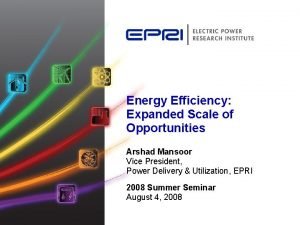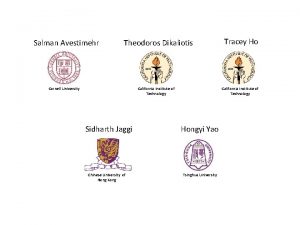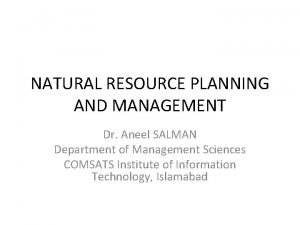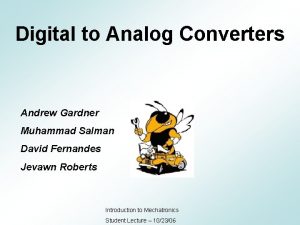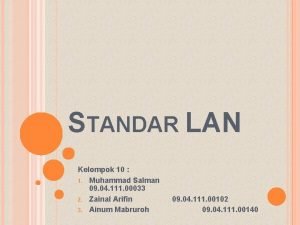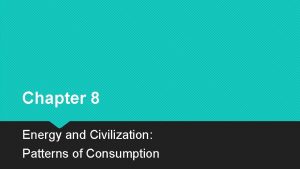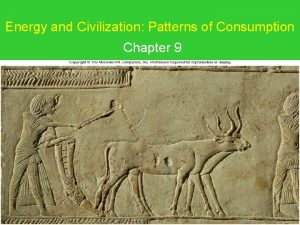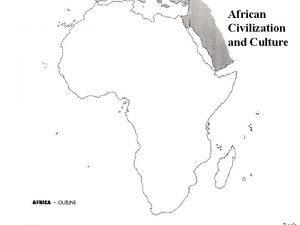Muhammad Salman Arshad Energy and Civilization Patterns of

























- Slides: 25

Muhammad Salman Arshad Energy and Civilization: Patterns of Consumptions

Chapter Objectives: After reading this chapter, you should be able to: • Explain why all organisms require a constant input of energy. • Describe how per capita energy consumption increased as civilization developed from hunting and gathering to primitive agriculture to advanced cultures. • Describe how advanced modern civilizations developed as new fuels were used to run machines. • Correlate the Industrial Revolution with social and economic changes. • Explain how cheap oil and natural gas led to a consumption-oriented society. • Explain how the automobile changed people’s lifestyles. • Explain why energy consumption is growing more rapidly in developing countries than in the industrialized world. • Describe the role of OPEC in determining oil prices.

History of Energy Consumption: • Every form of life and all societies require a constant input of energy. • If the flow of energy through organisms or societies ceases, they stop functioning and begin to disintegrate. Some organisms and societies are more energy efficient than others. • In general, complex industrial civilizations use more energy than simple hunter-gatherer or primitive agricultural cultures. • If modern societies are to survive, they must continue to expend energy. However, they may need to change their pattern of energy consumption as current sources become limited.

Biological Energy Sources • Energy is essential to maintain life. In every ecosystem, the sun provides that energy. • The first transfer of energy occurs during photosynthesis, when plants convert light energy into the chemical energy in the organic molecules they produce. • Herbivorous animals utilize the food energy in the plants. The herbivores, in turn, are a source of energy for carnivores.

Gathering of Energy:

• Because nearly all of their energy requirements were supplied by food, primitive humans were no different from other animals in their ecosystems. In such hunter-gatherer cultures, nearly all human energy needs were met by using plants an animals as food, tools, and fuel.

Increased Use of Wood • Early civilizations, such as the Aztecs, Chinese, Indians, Greeks, Egyptians, and Romans were culturally advanced, but their societies used human muscle, animal muscle, and burned biomass as sources of energy.

Continued… • Except for limited use of some wind-powered and water-powered devices such as ships and canoes, the controlled use of fire was the first use of energy in a form other than food. • Wood was the primary fuel. (Wood was also used for building materials and other cultural uses. ) The energy provided by wood enabled people to cook their food, heat their dwellings, and develop a primitive form of metallurgy. • Such advances separated humans from other animals. When dense populations of humans made heavy use of wood for fuel and building materials, they eventually used up the readily available sources and had to import wood or seek alternative forms of fuel.

The Industrial Revolution

The Role of the Auto-mobile • Although the Chinese used some oil and natural gas as early as 1000 B. C. , the oil well that Edwin L. Drake, an early oil prospector, drilled in Pennsylvania in 1859 was the beginning of the modern petroleum era. • For the first 60 years of production, the principal use of oil was to make kerosene, a fuel burned in lamps to provide lighting. • The gasoline produced was discarded as a waste product. During this time, oil was abundant relative to its demand, and thus, it had a low price.

Continued: … • The invention of the automobile dramatically increased the demand for oil products. In 1900, the United States had only 8000 automobiles. • By 1950, it had over 40 million cars, and by 2000, over 200 million. More oil was needed to make automobile fuel and lubricants. • During this period, the percentage of energy provided by oil increased from about 2 percent in 1900 to about 40 percent by 1950 and has remained at about 40 percent to the present.

Continued… • The growth of the automobile industry, first in the United States and then in other industrialized countries, led to roadway construction, which required energy. • Thus, the energy costs of driving a car were greater than just the fuel consumed in travel. As roads improved, higher speeds were possible. • Bigger and faster cars required more fuel and even better roads. • So roads were continually being improved, and better cars were being produced. A cycle of more chasing more had begun. • In North America and much of Europe, the convenience of the automobile encouraged two-car families, which created a demand for more energy.

Continued… • More cars meant more jobs in the automobile industry, the steel industry, the glass industry, and hundreds of other industries. • Constructing thousands of kilometers of roads created additional jobs. • Thus, the automobile industry played a major role in the economic development of the industrialized world. • All this wealth gave people more money for cars and other necessities of life. The car, originally a luxury, was now considered a necessity.

• The car also altered people’s lifestyles. Vacationers could travel greater distances. • New resorts and chains of motels, restaurants, and other businesses developed to serve the motoring public, creating thousands of new jobs. • Because people could live farther from work, they began to move to the suburbs. As people moved to the suburbs, they also changed their buying habits. Laborsaving, energy-consuming devices became essential in the home. • The vacuum cleaner, dishwasher, garbage disposal, and automatic garage door opener are only a few of the ways human power has been replaced with electrical power.


Industrial energy use • The amount of energy countries use for industrial processes varies considerably. Nonindustrial countries use little energy for industry. • Countries that are developing new industries dedicate a high percentage of their energy use to them. • They divert energy to the developing industries at the expense of other sectors of their economy. • Highly industrialized countries use a significant amount of their energy in industry, but their energy use is high in other sectors as well. In the United States, industry claims about 32% of the energy used.

Continued… • The amount of energy required in a country’s industrial sector depends on the types of industrial processes used. • Many countries use inefficient processes and could reduce their energy consumption by converting to more energy-efficient ones. However, they need capital investment to upgrade their industries and reduce energy consumption.

Transportation energy use: • As with residential, commercial, and industrial uses, the amount of energy used for transportation varies widely throughout the world. In some of the lessdeveloped nations, transportation uses are very small. Per capita energy use for transportation is larger in developing countries and highest in highly developed countries

• Once a country’s state of development has been taken into account, the specific combination of bus, rail, waterways, and private automobiles is the main factor in determining a country’s energy use for transportation. • In Europe, Latin America, and many other parts of the world, rail and bus transport are widely used because they are more efficient than private automobile travel, governments support these transportation methods, or a large part of the populace is unable to afford an automobile. • In countries with high population densities, rail and bus transport is particularly efficient. In general, automobiles require about twice the energy per passenger kilometer than does bus or rail transport. In addition, most of these countries have high taxes on fuel, which raise the cost to the consumer and encourage the use of public transport.

ELECTRICAL ENERGY • Electrical energy is such a large proportion of energy consumed in most countries that it deserves special comment. • Electricity is both a way that energy is consumed and a way that it is supplied. • Almost all electrical energy is produced as a result of burning fossil fuels. • Thus, we can look at electrical energy as a use to which fossil fuel energy is put. In the same way we use natural gas to heat homes, we can use natural gas to produce electricity.

Production of electrical energy: • Electrical energy can be produced in many ways. The primary methods of generating electricity are burning fossil fuels, nuclear power plants, hydroelectric plants, and other renewable methods (geothermal, wind, tidal, solar). The combination of methods used to generate electricity in any country depend on the natural resources of the country and government policy.

Continued: … • As with other forms of energy use, electrical consumption in different regions of the world varies widely. • The industrialized countries of the world, with about 20 percent of the world’s population, consume 60 percent of the world’s electricity. Less-developed nations of the world, which have about 80 percent of the world’s population, use 40 percent of the world’s electricity. • The per capita use of electricity in North America is 10 times greater than average per capita use in the lessdeveloped countries.

Issues and Analysis • Governments use economic tools to encourage desired behaviors. Taxes on goods or services artificially increase the price and encourage a search for alternatives. • Subsidies are a gift from government to encourage individuals or corporations to pursue certain kinds of activities. When regulations specify particular standards or actions, fines or fees are charged to those who do not meet the standards. • With respect to energy policy, there are several ways in which these tools are used:

1. The issue of global warming has generated the idea of a carbon tax. Carbon dioxide is released when fossil fuels are used, so a carbon tax would be a tax on energy. This tax would artificially raise the price of energy and cause people to change their behavior to use less energy or shift to forms of energy that release less carbon dioxide.

2. Taxes on gasoline and diesel fuel can be used to encourage consumers to change their driving habits or the kinds of vehicles they drive. 3. Oil companies receive large subsidies to encourage them to explore for oil. Small subsidies are also provided for the exploration of certain alternative energy sources such as solar energy and wind energy. 4. Fuel economy standards for motor vehicles require manufacturers to meet standards by a certain date or they must pay a fine.
 Dr muhammad salman
Dr muhammad salman Wa makaru wa makarallah arabic text
Wa makaru wa makarallah arabic text Durood ibrahim
Durood ibrahim Fenoina
Fenoina Specific objectives of asthma
Specific objectives of asthma Lums energy institute
Lums energy institute Nizamuddin arshad
Nizamuddin arshad Arshad mansoor
Arshad mansoor Arshad habib
Arshad habib Arshad usmani
Arshad usmani Dr arshad ali khan
Dr arshad ali khan Ahmed salman rushdie
Ahmed salman rushdie Salman avestimehr
Salman avestimehr Natural gender
Natural gender Dr salman arain
Dr salman arain Salman baig seo
Salman baig seo Salman mustafa
Salman mustafa Aneel salman
Aneel salman Salman hukuk
Salman hukuk Salman f rahman
Salman f rahman Salman azhar
Salman azhar Saad azhar saeed ucp
Saad azhar saeed ucp Salman ahmad awan
Salman ahmad awan Salman rudhdie
Salman rudhdie Deque salman
Deque salman Deque salman
Deque salman







